California Highway Patrol

California Highway Patrol

| California Highway Patrol | |
|---|---|
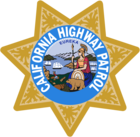 CHP Door Shield | |
 CHP Badge | |
 CHP Logo | |
| Abbreviation | CHP |
| Motto | Safety, Service, and Security |
| Agency overview | |
| Formed | August 14, 1929 (1929-08-14) |
| Employees | 10,870 (as of 2019)[1] |
| Annual budget | $2.5 billion (as of 2019) |
| Jurisdictional structure | |
| Operations jurisdiction | California, U.S. |
 | |
| Map of California Highway Patrol's jurisdiction. | |
| Size | 163,696 square miles (423,970 km2) |
| Population | 39,536,653 (2017 est.)[2] |
| Legal jurisdiction | As per operations jurisdiction |
| Governing body | California State Legislature |
| Constituting instrument |
|
| General nature |
|
| Headquarters | Sacramento, California, United States |
| Officers | 7,598 (as of 2019)[1] |
| Civilians | 3,272 (as of 2019)[1] |
| Commissioner responsible |
|
| Parent agency | California State Transportation Agency (CALSTA) |
| Facilities | |
| Commands | 8 Field Divisions 16 Commercial Enforcement Facilities 103 Area Offices |
| Patrol cars | Ford Explorer- based Police Interceptor Utility Vehicle |
| Patrol cars | Dodge Charger- Police |
| Motorcycles | BMW R1200RT-P |
| Planes | Cessna 206 |
| Website | |
| http://www.chp.ca.gov [45] http://www.chpcareers.com [46] https://www.facebook.com/CHPHQ [47] https://www.twitter.com/CHPHQ [48] | |
The California Highway Patrol (CHP) is a law enforcement agency of California. The CHP has patrol jurisdiction over all California highways and are also known as the state police. They also have jurisdiction over city roads, and have the right to conduct law enforcement procedures there.
The California State Legislature originally established the California Highway Patrol as a branch of the Division of Motor Vehicles in the Department of Public Works, with legislation signed by Governor C. C. Young on August 14, 1929. It was subsequently established as a separate department with legislation signed by Governor Earl Warren in 1947. The CHP gradually assumed increased responsibility beyond the enforcement of the State Vehicle Act and eventually merged with the smaller California State Police in 1995.[3] It is currently organized as part of the California State Transportation Agency (CALSTA).
In addition to its highway patrol duties, the CHP also provides other services including protecting state buildings and facilities (most notably the California State Capitol) and bodyguarding state officials. The CHP also works with municipal and federal law enforcement agencies, providing assistance in investigations, patrol and other aspects of law enforcement.
The California Highway Patrol is the largest state police agency in the United States, with more than 10,700 employees, 7,500 of whom are sworn officers, according to FBI data.[1]
| California Highway Patrol | |
|---|---|
 CHP Door Shield | |
 CHP Badge | |
 CHP Logo | |
| Abbreviation | CHP |
| Motto | Safety, Service, and Security |
| Agency overview | |
| Formed | August 14, 1929 (1929-08-14) |
| Employees | 10,870 (as of 2019)[1] |
| Annual budget | $2.5 billion (as of 2019) |
| Jurisdictional structure | |
| Operations jurisdiction | California, U.S. |
 | |
| Map of California Highway Patrol's jurisdiction. | |
| Size | 163,696 square miles (423,970 km2) |
| Population | 39,536,653 (2017 est.)[2] |
| Legal jurisdiction | As per operations jurisdiction |
| Governing body | California State Legislature |
| Constituting instrument |
|
| General nature |
|
| Headquarters | Sacramento, California, United States |
| Officers | 7,598 (as of 2019)[1] |
| Civilians | 3,272 (as of 2019)[1] |
| Commissioner responsible |
|
| Parent agency | California State Transportation Agency (CALSTA) |
| Facilities | |
| Commands | 8 Field Divisions 16 Commercial Enforcement Facilities 103 Area Offices |
| Patrol cars | Ford Explorer- based Police Interceptor Utility Vehicle |
| Patrol cars | Dodge Charger- Police |
| Motorcycles | BMW R1200RT-P |
| Planes | Cessna 206 |
| Website | |
| http://www.chp.ca.gov [45] http://www.chpcareers.com [46] https://www.facebook.com/CHPHQ [47] https://www.twitter.com/CHPHQ [48] | |
Duties
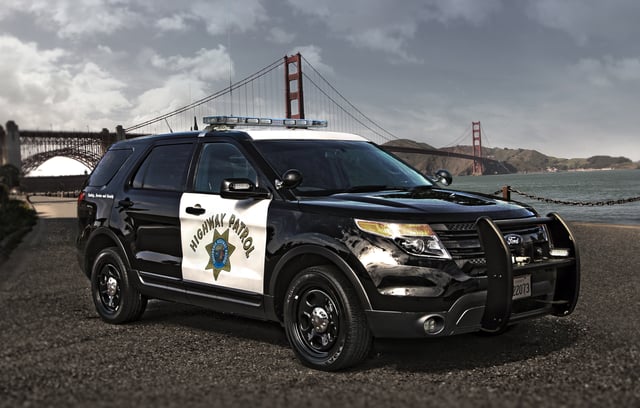
The Ford Police Interceptor Utility Vehicle replaced the Ford Crown Victoria Police Interceptor in 2013.
The agency is responsible for law enforcement on all California state routes (including all freeways and expressways), U.S. Highways, Interstate Highways and all public roads in unincorporated and incorporated portions of a county. Local police or the local sheriff's department having a contract with an incorporated city are primarily responsible for investigating and enforcing traffic laws in incorporated cities, but any peace officer of the CHP can still enforce any state law anywhere within the state, even though the agency's primary mission is related to transportation.[4] Furthermore, CHP officers act as bailiffs for the California Supreme Court and California Court of Appeal, as well as providing security at buildings occupied by the State of California.
CHP officers enforce the California Vehicle Code, pursue fugitives spotted on the highways, and attend to all significant obstructions and accidents within their jurisdiction. They patrol in various vehicles including Ford Crown Victoria Police Interceptors, Dodge Charger (LX)s, Chevrolet Camaros, BMW R1150RT‑P motorcycles, Cessna 206 airplanes, and helicopters which include Bell OH‑58As, Bell 206L‑IVs and Eurocopter AS‑350B‑3s. Beginning in 2013, the CHP switched to the Ford Explorer-based Ford Police Interceptor Utility fleet vehicles because the Ford Crown Victoria Police Interceptor was being phased out of production.
CHP officers are responsible for investigating and disposing of car accidents, disabled vehicles, debris, and other impediments to the free flow of traffic. They are often the first responders at the scene of an accident (or obstruction), and in turn summon paramedics, firefighters, tow truck drivers or Caltrans personnel. The CHP files traffic collision reports for state highways and within unincorporated areas. The CHP responds to and investigates all accidents involving school buses throughout the state including incorporated cities.
CHP also has Multidisciplinary Accident Investigation Teams (MAIT) for the investigation of traffic collisions.[5]
Special responsibilities

Members of the CHP SWAT Team
The CHP also publishes data on traffic accidents in California from a database called SWITRS (Statewide Integrated Traffic Records System).
After the September 11, 2001 attacks the CHP became responsible for securing and patrolling a number of potential terrorist targets in California. These sites include nuclear power plants, government buildings, and key infrastructure sites. The CHP also maintains a SWAT team on 24‑hour stand‑by to respond to any terrorist activity.
In September 2005, the CHP sent its two Mobile Field Forces (highly trained and equipped quick reaction/deployment teams for civil disturbances and/or disasters) to the Gulf Coast to assist in the aftermath of Hurricane Katrina. Before the United States National Guard arrived, the CHP had four patrol helicopters over Marianna, Florida, more than eighty vehicles on the ground, and more than 200 officers and other staff, including a SWAT team, deployed in New Orleans.[6]
The CHP also has officers assigned to drug task forces and other criminal investigative task forces throughout the state, and maintains highly trained Warrant Service Teams (WST) throughout each of its Divisions. These teams serve high-risk felony arrest and search warrants generated as a result of CHP investigations, and the WST assists local, state, and federal law enforcement agencies to serve the same type of high-risk warrants. CHP investigators also work closely with agents of the State Bureau of Investigation, Office of the Attorney General.
Additionally, the CHP has dozens of narcotic patrol and explosive detection K‑9 teams stationed throughout the state.
One of the California Highway Patrol's additional responsibilities includes a governor protection detail.
Pay and pensions
Average officer pay was $118,000 in 2014.[10] By law, salaries are set by an average of the five largest police departments in the state.[11] In 2012, the top paid CHP officer received $483,581, 44 other officers earning over $200,000, and over 5,000 officers receiving over $100,000.[11] In 2011, CHP officers earned $82.4 million in overtime, triple the amount in the second largest state, and with one officer earning over $93,000 in overtime alone.[11] Officers are strictly prohibited from working more than 16.5 hours at a time before having to take a minimum 8-hour break.[11]
In 1999, Governor Gray Davis signed SB 400, which allowed CHP officers to retire at age 50 and continue receiving as much as 90% of their peak pay as a pension.[12] This raised the pension earned for 30 years of service from an average of $62,218 to $96,270.[12] Officers' average retirement age is 54.[12] The private market cost for a similar annuity is $2.6 million.[12] Benefits promised by the State of California are currently $241 billion greater than funds it has actually committed to CalPERS.[12]
Organization
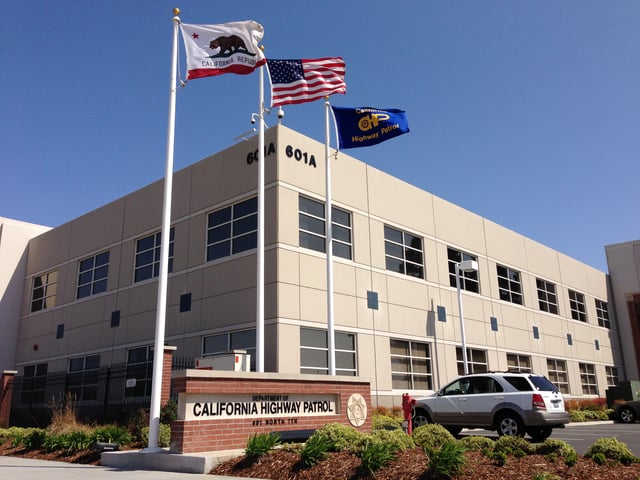
California Highway Patrol Headquarters in Sacramento, CA.

CHP Commissioner Warren Stanley
The CHP is led by the Commissioner, who is appointed by the Governor of California. The Deputy Commissioner is also appointed by the Governor and the Assistant Commissioners are appointed by the Commissioner.
On February 9, 2018, Governor Jerry Brown appointed Warren Stanley to succeed Joe Farrow as CHP Commissioner.
Hierarchy
Commissioner of the Highway Patrol — Warren Stanley[13][14] Deputy Commissioner of the Highway Patrol — Scott Silsbee Professional Standards and Ethics Division Office of Community Outreach & Media Relations Assistant Commissioner, Field Operations — Nick Norton Northern Division Valley Division Golden Gate Division Central Division Southern Division Border Division Coastal Division Inland Division Protective Services Division Office of Air Operations State Security Division Assistant Commissioner, Staff Operations — Amanda Ray Office of Employee Safety and Assistance Administrative Services Division Enforcement & Planning Division Information Management Division Special Counsel to the Commissioner
Rank structure
| Title | Insignia |
|---|---|
| Commissioner | or |
| Deputy Commissioner | |
| Assistant Commissioner | |
| Chief | |
| Assistant Chief | |
| Captain | |
| Lieutenant | |
| Sergeant | |
| Officer | No insignia |
| Cadet | No insignia |
Traditions
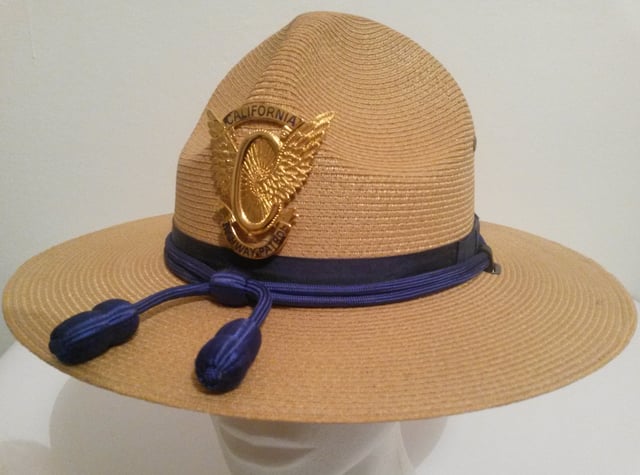
California Highway Patrol campaign hat.
CHP uniforms are traditionally khaki-colored with campaign hat and blue-and-gold trouser stripe. Command officers wear a tan combination cap. The dress uniform includes a forest green jacket and royal blue tie (bow tie for motor officers). Cold weather and utility uniforms are dark blue.
Leather gear is black basketweave leather with brass snaps and buckles.
Standard traffic enforcement patrol vehicles are required by state law to have a white door with, in the case of the CHP, a star. The CHP operates traditional black and white as well as all-white patrol vehicles.
The California Highway Patrol is one of the few organizations to continue to use the older toll-free "Zenith 1‑2000" number. With the falling cost of telephone area code 800 and 888 numbers, most organizations have chosen to switch to one of the newer numbers and discontinue use of the Zenith service, which requires operator assistance. The CHP's traditions include its own radio codes, widely adopted by local agencies. The most important is 11‑99, which signifies that an officer needs emergency assistance or that an officer is down.
In 1981, a charitable foundation called the 11‑99 Foundation was founded to provide benefits and scholarships to officers and their families. The members of the foundation's board of directors have provided over $16 million in assistance to current, retired, and those fallen in the line of duty CHP employees and their families. The organization's name is taken from the radio code.[15] There has been some mild controversy over whether the issuing of metal license plate frames to members of this foundation, often seen installed around the rear license plate, might result in any special treatment of member motorists by CHP officers.
Seven points of the CHP badge
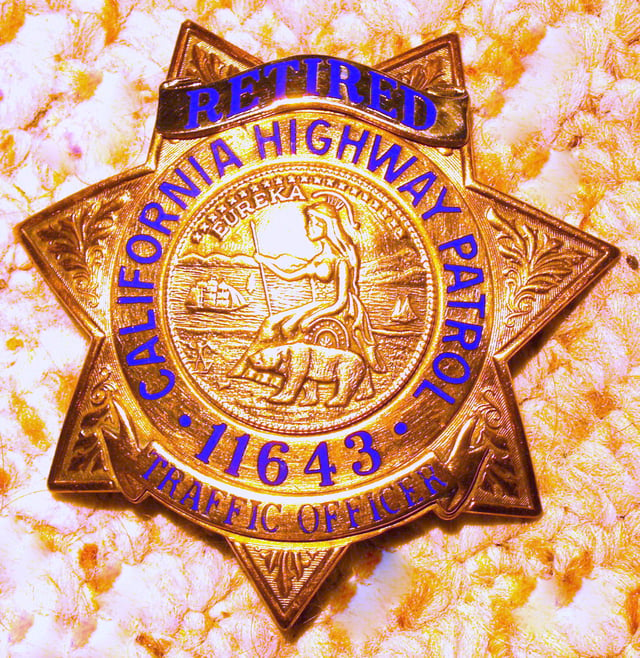
CHP badge. This is for retired officer #11643. Active duty badges are exactly the same, with the "Retired" banner not applied.
The badge of the California Highway Patrol is a gold seven-point star with the California state seal in the center, and a ribbon with the rank of the badge holder on the bottom. The star points have oak leaves in them, and badges are made of 14k gold-filled brass. A patch facsimile is worn on tactical and utility uniforms, and optionally on the cold weather jacket. The cap piece is a golden winged wheel with banners stating the agency name.
Character: The qualities of moral strength, vigor, and stability (11:00)
Integrity: The moral defense against corrupting influence (1:00)
Knowledge: Acquaintance with facts and laws, combined with the awareness and understanding that sustain an officer through daily duties (9:00)
Judgment: The ability to apply knowledge to the best advantage of all concerned (3:00)
Honor: Highest esteem for the principles upon which the California Highway Patrol has been built (7:00)
Loyalty: Faithfulness to the precepts of the Highway Patrol and to fellow officers (5:00)
Courtesy: Respect for law and order and for the individual (6:00)
Code of honor
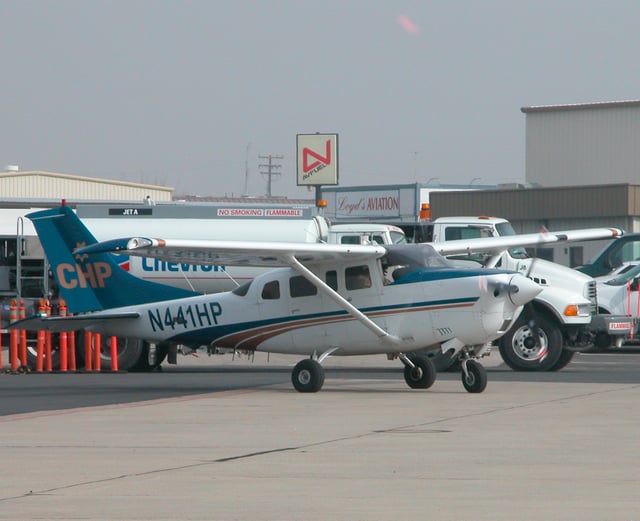
A CHP Cessna 206 prepares to depart Meadows Field Airport, Bakersfield, California
The CHP has a code of honor. It states:
I, a member of the California Highway Patrol, subscribe in word and deed to the following: To serve the United States of America and the State of California honestly, and conscientiously; and fulfill my oath as a soldier of the law; To uphold and maintain the honor and integrity of the California Highway Patrol; Be loyal to my fellow officers; respect and obey my seniors in rank; and enforce the law without fear, favor, or discrimination; Assist those in peril or distress, and, if necessary, lay down my life rather than swerve from the path of duty; My personal conduct shall at all times be above reproach and I will never knowingly commit any act that will in any way bring discredit upon the California Highway Patrol or any member thereof; To all of this I do solemnly pledge my sacred honor as an Officer of the California Highway Patrol.
Fallen officers
Since its inception in 1929, 226 officers have died in the line of duty. The top three frequent causes of line of duty deaths to date are (in order of cause): Automobile/Motorcycle Accidents, Gunfire, and Vehicular Assault (i.e., struck by drunk driver, reckless driving, or hearing and/or visually impaired drivers).[16] 1964 was the deadliest year, in which eight officers died in the line of duty; 1970 and 1978 were the second deadliest years, in which seven officers died in the line of duty.
Mexico Liaison Unit

A CHP Dodge Charger on a Unknown Trouble
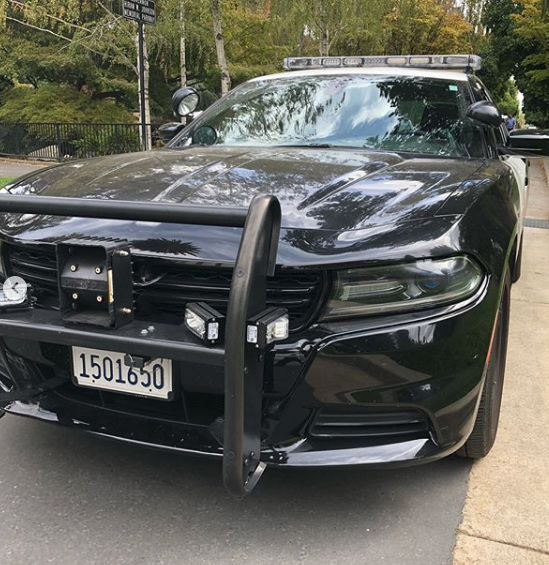
A CHP Dodge Charger at the Sacramento Capitol Building
The "Mexico Liaison Unit" is a Border Division Unit based in San Diego. Since the CHP has no jurisdiction directly in Mexico, officers from the Unit work closely with Mexican authorities to recover stolen vehicles and assist with other law enforcement issues. The purpose of the "Mexico Liaison Unit" is to develop and maintain positive working relations with Mexican authorities in order to:
Locate and identify stolen U.S. vehicles taken to Mexico
Identify vehicle thieves and ensure their prosecution, either in Mexico or California
Provide assistance to Mexican and U.S. authorities
The unit was originally established in 1958 and only consisted of one officer. It was discontinued in the 1970s, and reestablished in 1980. The unit now consists of one sergeant and six officers, all of whom are fluent in Spanish.[17]
Newhall incident
On April 6, 1970, four California Highway Patrol officers were killed in a 4½‑minute shootout in the Newhall region of Southern California. The incident is a landmark in CHP history because of both its emotional impact and the procedural and doctrinal reforms implemented by the CHP in the incident's aftermath.
The shootout occurred in a restaurant parking lot just before midnight. Officers Walt Frago and Roger Gore were alerted by radio of a vehicle carrying someone who brandished a weapon. They spotted the car, fell in behind, called for backup, and began the stop procedure. When the suspects' vehicle came to a halt in the parking lot, the driver was instructed to step out of the vehicle and spread his hands on the hood. Gore approached him and Frago moved to the passenger side. The passenger side door suddenly swung open and the passenger sprung out, firing at Frago, who fell with two shots in his chest. The gunman, later identified as Jack Twinning, then turned and fired once at Gore, who returned fire. In that moment the driver, Bobby Davis, turned and shot Gore twice at close range. Both officers died instantly.
When Officers James Pence and George Alleyn drove in moments later, they could not see suspects or other officers, but both immediately came under fire. Pence put out an 11‑99 call ("officer needs help, emergency") then took cover behind the passenger door. Alleyn grabbed his shotgun, and positioned himself behind the driver-side door. Both officers were mortally wounded in the ensuing exchange, and one suspect was hit.
Civilian Gary Kness saw the gunfight as he drove along The Old Road and stopped to help. Kness ran toward the gun battle as shots were still being fired.
"I was driving to work as a computer operator when I turned the corner on the Old Road and saw the gunfire, I saw two CHP cars and a red car. I always say my brain said to get out of the way, but my feet ran the wrong way."[18]
Kness tried to drag the mortally wounded Alleyn out of the line of fire. When one of the two assailants began firing at him, Kness grabbed a CHP shotgun lying on the ground and aimed it at one of the gunmen. The shotgun was empty, however. Kness grabbed Alleyn's service pistol from the ground, aimed with both hands and fired, hitting gunman Bobby Augusta Davis in the chest. When Davis kept advancing toward him, Kness tried to shoot again, but the CHP pistol was out of bullets.
"I was upset there weren't four or five more rounds in there. After that, I ran and jumped in a ditch. The dumbest thing is, I still had the service revolver in my hand. I was afraid when more police came they'd think I was one of the gunman. So I put it behind me and said, 'They went that way.'"[18]
Suspects Jack Twinning and Bobby Davis escaped, later abandoned their vehicle and then split up. For nine hours, officers blanketed the area searching for the killers. Twinning broke into a house and briefly held a man hostage. Officers used tear gas before storming the house, but Twinning committed suicide with the shotgun he stole from Frago. Davis was captured, stood trial and convicted on four counts of murder. He was sentenced to death, but in 1972, the California Supreme Court declared the death penalty to be cruel and unusual punishment and in 1973, the court commuted his sentence to life in prison.
Of the incident, Ronald Reagan, who was governor of California at the time, said the following words: "If anything worthwhile comes of this tragedy, it should be the realization by every citizen that often the only thing that stands between them and losing everything they hold dear ... is the man wearing a badge."[19]
A follow-up investigation eventually led to a complete revision of procedures during high-risk and felony stops. Firearms procedures have also changed fundamentally due to this incident, and physical methods of arrest have been improved. The police baton and pepper spray have been added to the officer's arsenal, with more in‑depth training in their use.[20]
The 25th anniversary of the Newhall Incident was observed on April 6, 1995, at the present Newhall Area office, where a brick memorial pays tribute to Officers James Pence (6885), Roger Gore (6547), Walt Frago (6520) and George Alleyn (6290). The memorial once stood at the former Newhall office, but was rebuilt at the new site, about one mile (1.6 km) from the scene of the slayings.[21]
Mergers
On July 12, 1995, the California State Police, which was a separate agency, was merged into the CHP, thus greatly expanding the agency's mandate.[3] In addition to safety on the state highway system, it is now responsible for the safety of all elected state officials and all people who work in or are utilizing a state building in California, such as the State Capitol Building in Sacramento.
It has also been discussed to merge the Law Enforcement Division of the California Department of Fish and Wildlife into the California Highway Patrol.[22][23] By doing so, this may allow for better protection of California's environment and natural resources. The underfunded CDFW Law Enforcement Division[24][25][26] has faced low numbers of Game Wardens also known as Wildlife Officers for the last ten years; a similar idea is already in place in Oregon and Alaska, where the Oregon State Police[27] and Alaska State Troopers[28] serve as game wardens under a separate fish and wildlife division within the two departments.
Weapons
The current department issued firearm for CHP officers is the Smith & Wesson M&P40, which replaced the Smith & Wesson Model 4006 TSW in 2017. Each CHP patrol car is equipped with a Remington Model 870 Police Magnum 12-gauge shotgun and a SIG Sauer SIGM400 rifle in .223 Remington. Less-lethal weapons include oleoresin capsicum spray, less-lethal shotguns and side-handle batons. The ASP, Inc. Expandable Straight Baton is authorized as an optional piece of equipment. Additionally, all officers are authorized to carry a Taser. As of early 2009, officers have been allowed to mount weapon-mounted lights to their pistols.
Vehicles
Origins
When motor vehicles in California were first seen as needing legislation, law enforcement agencies began to patrol using motorcycles, cars and trucks.[29] [] Motorcycle officers in 1920 Fresno, started a group to assist each other and promote road safety – the Joaquin Valley Traffic Officer's Association – led by Harry Wilson who they elected as president. They renamed themselves the California Association of Highway Patrolmen in 1921, and became the California Highway Patrol in 1927 under the auspices of the Department of Motor Vehicles.[29] []
Motorcycles

A motorcycle sergeant on the San Tomas Expressway near Benton Avenue in Santa Clara, California.
Through the public competitive bidding process, the Harley-Davidson motorcycle was selected as the primary enforcement motorcycle for the California Highway Patrol in 2013.
These replacement enforcement motorcycles will replenish the Department's aging motorcycle fleet. In a cost-saving move, the CHP previously deferred the purchase of replacement motorcycles and has not purchased enforcement motorcycles since January 14, 2011. As a result, approximately 20 percent of the current fleet has logged 100,000 plus miles – well exceeding the manufacturer's warranty.
CHP's motorcycle program enhances public safety. Motorcycle officers are able to effectively enforce traffic laws in areas in which enforcement by four-wheel vehicles is impractical. Motorcycles can access scenes of accidents and natural disasters more quickly and work commute traffic in way that is unique to the motorcycle. Additionally, motorcycles play a special role in dignitary protection.
The CHP has approximately 415 enforcement motorcycles working the roads throughout California. The CHP purchased 121 of the Harley-Davidson enforcement motorcycles to replace motorcycles that have high mileage or have been damaged in traffic collisions. As of June 2013, approximately 22 percent of the CHP's motorcycle fleet is over 100,000 miles with more than half of those over 125,000 miles. On average, a CHP enforcement motorcycle is driven 14,000 miles per year.
The Harley-Davidson FLHTP Enforcement Motorcycle price per unit is $28,381.00. This includes a 3-year/60,000-mile warranty that covers all service and repairs.
Vehicles
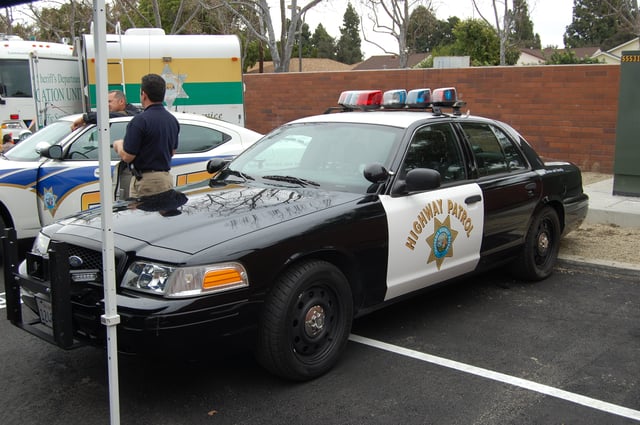
California Highway Patrol cruiser on display at Public Safety Day in Lakewood, California.
The Department of General Services is responsible for selecting a vehicle based on price, performance and payload capacity for the CHP. The bid specifications require a pursuit-rated, rear-wheel drive or all-wheel drive that can carry at least 1,500 pounds, the approximate weight of four officers, their equipment, and the police vehicle equipment.
As of July 2013, CHP had not purchased patrol vehicles since January 2011 and their fleet was rapidly aging. On average, CHP patrol vehicles are driven 33,000 miles per year. Half of their 2,153-vehicle fleet had over 100,000 miles as of June 2013. After 100,000 miles, the warranty on CHP vehicles expires, forcing CHP to pay for maintenance costs. In July 2013, the CHP was authorized to purchase up to 751 new vehicles to begin replacing its aging fleet, starting with cars that have the highest mileage.
Through a public, competitive bidding process, the Ford Police Interceptor Utility Vehicle (Explorer) was selected as the new enforcement vehicle for the CHP in 2013. The Ford Police Interceptor Utility Vehicle is All Wheel Drive and powered by a V6, 3.7 Liter engine. It is a Flex Fuel vehicle that can use gasoline or E85 and gets 16 mpg city and 21 mpg highway.
Several Dodge Charger Police Packages were also purchased for testing.
The Ford Crown Victoria Police Interceptor averaged 14 mpg city and 21 mpg highway. The new Ford Police Interceptor Utility Vehicle costs $26,578, which includes a 5-year, 100,000-mile warranty. The Department was paying $24,043 for the Ford Crown Victoria Police Interceptors and recently spent hundreds of thousands of dollars per month to maintain all vehicles no longer covered by warranty. Several vehicles were allocated to public affairs officers and are used for recruiting purposes. An example of these vehicles can be seen at the California State Fair and other venues. CHP also uses Chevrolet Silverados, Dodge Rams (for commercial vehicle enforcement), Ford Expeditions, and Dodge Durangos for their divisions that snow frequently or have certain terrains to permit off-road driving.
In July 2016, it was announced that the CHP would be taking delivery of 516 2016 Dodge Chargers.[32] These cars are hoped to be more reliable than the Ford Police Interceptor Utility Vehicle, which have been plagued with various recalls and breakdowns, most notably, transmission failures.
In 2017, it was announced that the CHP were going to start using Chevrolet Tahoe Police Patrol Vehicles (PPV) for rural and resident posts. This is because of their ability to carry a larger "basic load" of normal issue equipment, equipment that may be only in a few cars, and / or not carried by patrol cars at all, in a more urban setting.
Aircraft
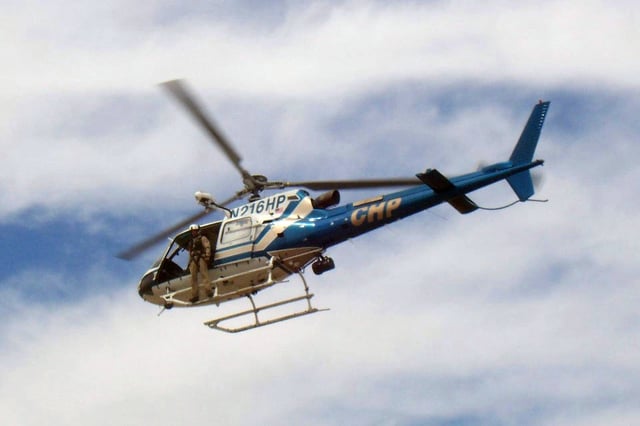
CHP AS 350 B3 in flight.
The CHP utilizes both helicopters and fixed-wing aircraft. In 2017 the fleet consisted of:[33]
11 Cessna T206H Turbo Stationairs
4 Gippsaero GA8 TC-320 Airvans
1 Cessna 182S Skylane
1 Raytheon (Beechcraft) B300 Super King Air
Rogue officers
George Gwaltney
A former officer from Barstow, was convicted on May 10, 1984 in federal court for the on‑duty rape and slaying of 23-year-old Robin Bishop on January 11, 1982. He had reported finding a dead body off a deserted stretch of interstate 15 the same day he murdered her with his service weapon. Gwaltney was tried twice for this murder at the San Bernardino County Court House. The first trial ended with the jury deadlocked 8–4 and the second 7–5. The district attorney attempted to try Gwaltney a third time, but a Superior court judge dismissed the murder charge. Since Gwaltney was allowed to go free for the first two state trials, the FBI took over the case. The FBI was able to piece together the events leading up to the slaying and the on-duty rape of Robin Bishop and interrogating Gwaltney's alibi, Preston Olson and his mother. There was more forensic evidence that the FBI succeeded in getting to build their case against Gwaltney; soon his story started to fall apart. After the six-month investigation by the FBI, George Michael Gwaltney was arrested in Barstow and tried at the US District Court in Los Angeles. He was represented by a public defender who chose not to have Gwaltney testify as he had done in the previous two state trials. He was found guilty of the slaying, rape and the deprivation of Robin Bishop's civil rights while on duty. He was the first California Highway Patrol officer to be charged with the indictment of violating the civil rights of Robin Bishop as well as being the first CHP officer to commit a murder while on duty. Following the conviction, Gwaltney was subsequently sentenced to 90 years, being eligible for parole after serving at least 30 years. Gwaltney died in federal custody from a heart attack.[34]
Craig Peyer
A former officer from Poway, is serving a 25-years-to-life prison sentence for the on-duty strangulation and murder of 20-year-old Cara Knott on December 27, 1986. After she was killed, Knott's body was discarded over an abandoned highway bridge. Peyer was convicted of first-degree murder in 1988. Though he has maintained innocence ever since, Peyer has been denied parole consistently.[35] In 2004, the parole board offered Peyer the chance to prove his alleged innocence by providing a DNA sample to compare against a drop of blood found on Cara's shoe, using modern DNA profiling. Peyer declined to provide a sample, nor explain why he declined to do so.
Brad Wheat
Brad Wheat, an off-duty California Highway Patrol Officer got into a dispute outside of a "Get Ripped Nutrition" in Martell, Amador County, California on August 4, 2018. He had a weapon and the store owner was going to call 911 before he shot the owner, his wife, and himself. The owner managed to escape despite his injury and called 911. Wheat's wife and Wheat were killed instantly.[36]
Michael Joslin
A former officer from Pioneer was arrested for continuously molesting and raping a 12-year-old girl on August 13, 2018. He was charged with oral copulation with a minor under 14, lewd acts with a child under 14, continuous sexual abuse of a child, penetration with a foreign object and rape. The Amador County Sheriff's Department was tipped off by a local Church pastor after the victim and her mother came forward with the alleged abuse. The Amador County Sheriff's detectives and the department learned that the alleged molestation had been taking place for the past year. Joslin was employed with the California Highway Patrol Amador area office until August 14, when he was removed from the position. From July 1, 2009, until March 2, 2016, he was employed at the San Andreas area office. He graduated from the CHP Academy in West Sacramento on June 18, 2007. Joslin appeared in court and pleaded not guilty to the charges he had against him and was ordered to turn in his firearms. A protective order was imposed on Joslin in court, prohibiting him from contacting the victim in any capacity. He was held at the Amador County Jail.
On March 4, 2019, Joslin plead guilty to one count of sexual penetration by foreign object and one count of rape by force or fear in exchange for the remaining charges being dismissed. On April 16, he was sentenced to a total of 19 years in prison.[37] Joslin will be eligible for parole in 2033.[38]
This may need to be updated until further notice.
Media references
CHiPs was a fictional television drama show (1977–1983) about the CHP, and the CHP helped out in the 1955 TV show Highway Patrol starring Broderick Crawford. Also the CHiPs TV series was made into a modern television film called CHiPs '99. A comical motion picture version of the show has been released in 2017 (CHIPS) but it has not been endorsed by the CHP at all.
Former CHP Commissioner Maury Hannigan was the host of the syndicated TV series Real Stories of the Highway Patrol, which aired in the mid-to-late 1990s. The show featured not just the CHP, but also the Minnesota State Patrol, the Nevada Highway Patrol, the Alaska State Troopers, the South Dakota Highway Patrol, the Rhode Island State Police, the Massachusetts State Police, the West Virginia State Police and many other state police and highway patrol agencies in the United State of America, and in one episode, the Royal Newfoundland Constabulary. The series featured selected stories from state troopers and highway patrol officials from throughout North America who put themselves at great risk to apprehend those who instigated crime on their highways.
In the science-fiction film Rise of the Planet of the Apes where they are assigned to shoot down several apes led by Caesar who have escaped from cages. The rebellious apes win the battle using a strategem that overwhelms the CHP and escape into the Muir Woods Forest.
The TV movie Smash Up on I5 is about the San Juan Capistrano Area Office of the CHP in 1976
The CHP have a small role in Sky Heist, in Terminator: Genisys and in Buddy Buddy (Walter Matthau & Jack Lemmon, 1981)
In the Cory Doctorow novel Little Brother the CHP liberates the Department of Homeland Security's "Gitmo-by-the-Bay" detention facility.
CHP officers can be seen in the movie Drive a Crooked Road (Richard Quine & Jack Corrick, 1954).
It is parodied in Grand Theft Auto V as the San Andreas Highway Patrol (SAHP); additionally, players can acquire their uniform after completing the main story.
Comedian Gabriel Iglesias is notorious for his comical altercations with the CHP. These include offering an officer donuts and pretending to get arrested to frighten his son.
In the film Need for Speed, the CHP is shown in pursuit of racers in the De Leon race.
A CHP officer and car can be seen in the 1960 film Psycho, directed by Alfred Hitchock.
CHP is also seen in Gone in 60 Seconds (2000).
CHP is also seen in True Detective where one of the main characters in the second season is an officer.
In the NCIS: Los Angeles episode "Empty Quiver", two of the main characters go undercover as CHP motor officers to infiltrate a corrupt ring of CHP officers known as "The Golden Taxi Service". In the same episode, another one of the main characters makes references to seeing the television show CHiPs and made him want to become a police officer.
In the A-Team, S1E10, the team use a false CHP car to stop a truck.
Programs
The CHP hosts or partners with numerous programs for public safety education and community involvement.
Youth programs
Start Smart – a class for prospective and new teen drivers
Every 15 Minutes – a two-day anti-drunk driving presentation for high school students
Impact Teen Drivers – a nonprofit against teen distracted driving that is partnered with the CHP
Make the Right Turn – aimed at educating 11- to 14-year-olds about drugs and peer pressure
CHP Explorer Program – A law enforcement career exploration program for teenagers ages 15–21 years old who are interested in becoming a CHP Officer.
Sober Graduation – promoting sober driving and the use of a designated driver for teens
Red Ribbon Week – a week in October dedicated to education about the dangers of illicit drugs for students of all ages
Vehicle Theft Recognition and Awards Program
10851 Award for Superior Efforts in Vehicle Theft Arrests and Recovery. The CHP developed the 10851 Awards Program to recognize the superior efforts made by CHP and allied law enforcement personnel who have met specified criteria toward the reduction of stolen vehicle crimes. This includes actual arrests made of suspects charged with California Vehicle Code Section 10851 – Vehicle Theft. The CHP, in conjunction with the California State Automobile Association, presented an estimated 2,009 awards in 1995 to the more than 170 allied agencies participating in the 10851 Awards Program.[39]
Other programs
Highway Safety Corridor Program – promoting caution on roads with high accident rates
Senior Volunteer Program – Citizens ages 55 and older can volunteer their time to help the CHP out in their community.
Designated Driver Program – program to reduce drunk driving incidents through using a designated driver
Origins of the name
When the CHP was formed, there were discussions as to what to call this new agency. The consensus was for the name "California Highway Patrol". The American Automobile Association (AAA) is a private organization which provided, among other things, roadside assistance to their members. At that time, the AAA had a fleet of trucks which patrolled the roads so they could assist their members. These trucks carried a sign which said "Highway Patrol". The CHP organizers decided it would be best to contact the AAA to see if they would object to the state using this name. The AAA considered the idea, and gave their consent.[40]
See also
Highway patrol
List of law enforcement agencies in California
State patrol


